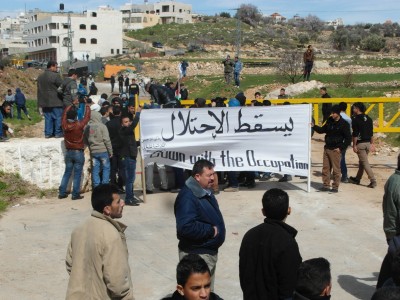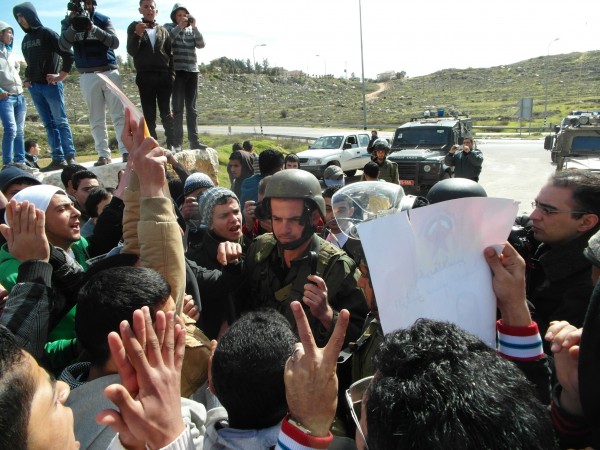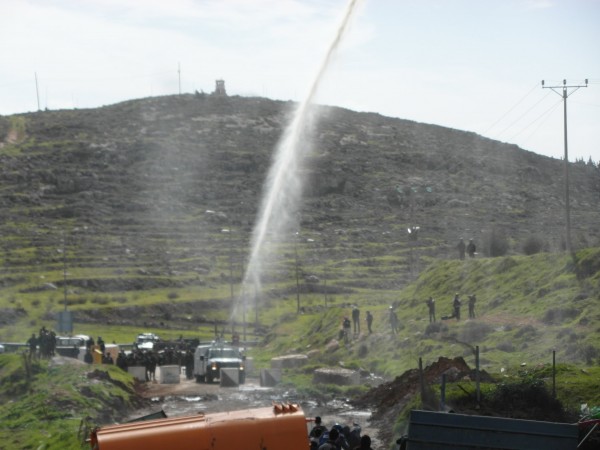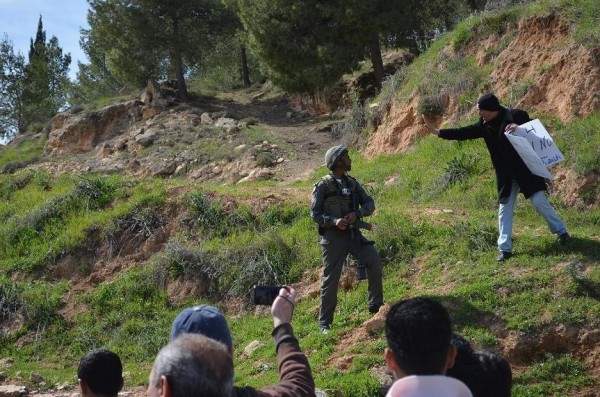“Settling” constitutes a warcime according to international law and ICC statute. Even under US’ own military legislations’
Law resources below this article
15 February 2013 | International Solidarity Movement, Hebron, Occupied Palestine
Follow @IsmPalestine
A peaceful demonstration was violently broken up by the Israeli occupation forces using tear gas grenades and canisters, and skunk water. Road opened for the first time in 13 years.
At 1pm around 100 Palestinians marched towards the Hagai road gate in the Al Hareaq area of Hebron. The demonstrators surprised the Israeli army who did not appear to be prepared for the demo, having to bring in reinforcements to the scene. The demonstrators gathered beyond the gate on the side facing the illegal Israeli settlement of Hagai. There was a tense atmosphere as the demonstrators chanted and vented their anger at the illegal road closure.
Demonstrators head towards Hagai road gate
Demonstrators started to dismantle the road gate taking parts of the gate away with them, they then pulled a chain out from within the gate and forced it open. People cheered and danced as this is the first time the road has been opened since it was closed by the Israeli military in 2000.
Soldiers started to throw sound grenades into the crowd who remained steadfast. Then an officer ordered a soldier to throw a tear gas grenade into the crowd. Demonstrators remonstrated with the soldier forcing him to back down. The officer then got another soldier to throw a tear gas grenade directly at a protestor hitting him in the side. After kicking away the tear gas grenade the demonstrators regrouped and continued to protest. Many more tear gas and sound grenades were thrown but the soldiers were unable to disperse the crowd and deny the Palestinians their right to peaceful protest. Three soldiers attempted to arrest a demonstrator at random but people quickly saw the danger and again thwarted the army by affecting a non violent de-arrest.
Soldier fails to arrest demonstrator
Refusing to move, the demonstrators continued chanting and making their views known to the soldiers,the media, and the wider world. At 2pm the organisers of the protest and respected elders started to end the demonstration. It has been a feature of the demonstrations here that they have been non violent and disciplined, with the demonstrators ending the protest on their own terms.
As the demonstration was ending, the Israeli army brought up a skunk truck and sprayed the foul smelling, noxious water at the crowd, also firing a large number of tear gas canisters at people as they were walking away. There were no arrests at the demonstration.
Skunk water is sprayed at the demonstrators
The Israeli occupation forces closed the road in 2000 with large concrete blocks. This prevented access to the south of Hebron from Dura, the close by Al Fawwar refugee camp and many villages in the area south west of Hebron. The barrier cuts off Hebron from over a hundred thousand people. For Palestinians in this area a journey of 5 or 6 minutes to Al Fawwar refugee camp now takes an hour.
Two weeks ago under pressure from the regular Friday demo the army removed the concrete blocks and put a road gate there instead. This is an attempt to show the road can be opened, but control of access would still lie in Israeli hands. In 2000 Israeli military bulldozers built sandhills on the road to further restrict movement. Pipes had been damaged on the road and sewage flowed onto the street, causing a hazard to peoples health. Last week the Hebron municipality mended the pipes and did further work to improve the road. With the weekly demonstrations and pressure on the District Coordination Office, the people southern Hebron, Dura, Al Fawwar and numerous villages in the south Hebron hills feel they may be able to remove this instrument of oppression and open the road for good.
Soldier attempting to arrest another demonstrator
VIDEOS
![]()
LAW
“States may not deport or transfer parts of their own civilian population into a territory they occupy.”
Summary
State practice establishes this rule as a norm of customary international law applicable in international armed conflicts.
International armed conflicts
The prohibition on deporting or transferring parts of a State’s own civilian population into the territory it occupies is set forth in the Fourth Geneva Convention.[1]
It is a grave breach of Additional Protocol I.[2]
Under the Statute of the International Criminal Court, “the transfer, directly or indirectly, by the Occupying Power of parts of its own civilian population into the territory it occupies” constitutes a war crime in international armed conflicts.[3]
Many military manuals prohibit the deportation or transfer by a party to the conflict of parts of its civilian population into the territory it occupies.[4]
This rule is included in the legislation of numerous States.[5]
Official statements and reported practice also support the prohibition on transferring one’s own civilian population into occupied territory.[6]
Attempts to alter the demographic composition of an occupied territory have been condemned by the UN Security Council.[7]
In 1992, it called for the cessation of attempts to change the ethnic composition of the population, anywhere in the former Yugoslavia.[8]
Similarly, the UN General Assembly and UN Commission on Human Rights have condemned settlement practices.[9]
According to the final report of the UN Special Rapporteur on the Human Rights Dimensions of Population Transfer, including the Implantation of Settlers and Settlements, “the implantation of settlers” is unlawful and engages State responsibility and the criminal responsibility of individuals.[10]
In 1981, the 24th International Conference of the Red Cross reaffirmed that “settlements in occupied territory are incompatible with article 27 and 49 of the Fourth Geneva Convention”.[11]
In the Case of the Major War Criminals in 1946, the International Military Tribunal at Nuremberg found two of the accused guilty of attempting the “Germanization” of occupied territories.[12]
References
[1] Fourth Geneva Convention, Article 49, sixth paragraph (cited in Vol. II, Ch. 38, § 334).
[2] Additional Protocol I, Article 85(4)(a) (adopted by consensus) (ibid., § 335).
[3] ICC Statute, Article 8(2)(b)(viii) (ibid., § 336).
[4] See, e.g., the military manuals of Argentina (ibid., §§ 346–347), Australia (ibid., § 348), Canada (ibid., § 349), Croatia (ibid., § 350), Hungary (ibid., § 351), Italy (ibid., § 352), Netherlands (ibid., § 353), New Zealand (ibid., § 354), Spain (ibid., § 355), Sweden (ibid., § 357), Switzerland (ibid., § 357), United Kingdom (ibid., § 358) and United States (ibid., § 359).
[5] See, e.g., the legislation of Armenia (ibid., § 361), Australia (ibid., §§ 362–363), Azerbaijan (ibid., §§ 364–365), Bangladesh (ibid., § 366), Belarus (ibid., § 367), Belgium (ibid., § 368), Bosnia and Herzegovina (ibid., § 369), Canada (ibid., §§ 371–372), Congo (ibid., § 373), Cook Islands (ibid., § 374), Croatia (ibid., § 375), Cyprus (ibid., § 376), Czech Republic (ibid., § 377), Germany (ibid., § 379), Georgia (ibid., § 380), Ireland (ibid., § 381), Mali (ibid., § 384), Republic of Moldova (ibid., § 385), Netherlands (ibid., § 386), New Zealand (ibid., §§ 387–388), Niger (ibid., § 390), Norway (ibid., § 391), Slovakia (ibid., § 392), Slovenia (ibid., § 393), Spain (ibid., § 394), Tajikistan (ibid., § 395), United Kingdom (ibid., §§ 397–398), Yugoslavia (ibid., § 399) and Zimbabwe (ibid., § 400); see also the draft legislation of Argentina (ibid., § 360), Burundi (ibid., § 370), Jordan (ibid., § 382), Lebanon (ibid., § 383) and Trinidad and Tobago (ibid., § 396).
[6] See, e.g., the statements of Kuwait (ibid., § 405) and United States (ibid., §§ 406–407) and the reported practice of Egypt (ibid., § 402) and France (ibid., § 403).
[7] See, e.g., UN Security Council, Res. 446 , 452 and 476 (ibid., § 408), Res. 465 (ibid., § 409) and Res. 677 (ibid., § 410).
[8] UN Security Council, Res. 752 (ibid., § 411).
[9] See, e.g., UN General Assembly, Res. 36/147 C, 37/88 C, 38/79 D, 39/95 D and 40/161 D (ibid., § 412) and Res. 54/78 (ibid., § 405); UN Commission on Human Rights, Res. 2001/7 (ibid., § 413).
[10] UN Sub-Commission on Human Rights, Final report of the Special Rapporteur on the Human Rights Dimensions of Population Transfer, including the Implantation of Settlers and Settlements (ibid., § 415).
[11] 24th International Conference of the Red Cross, Res. III (ibid., § 419).
[12] International Military Tribunal at Nuremberg, Case of the Major War Criminals, Judgement (ibid., § 421).
Source Article from http://occupiedpalestine.wordpress.com/2013/02/16/videos-demonstrators-open-hagai-road-gate-for-first-time-in-decade/
Views: 0
 RSS Feed
RSS Feed















 February 17th, 2013
February 17th, 2013  FAKE NEWS for the Zionist agenda
FAKE NEWS for the Zionist agenda 



 Still live in fairy-tale-land about Israel? Time to wake up: The Map of the “Greater Israel” even is hammered on the currency:All facts at Storify continuously updated. Read what Israeli ‘leaders’ have said and done even before (peace) talks and how their actions contradict the reality and ugly facts which they try to hide from you:
Still live in fairy-tale-land about Israel? Time to wake up: The Map of the “Greater Israel” even is hammered on the currency:All facts at Storify continuously updated. Read what Israeli ‘leaders’ have said and done even before (peace) talks and how their actions contradict the reality and ugly facts which they try to hide from you: Posted in
Posted in 














